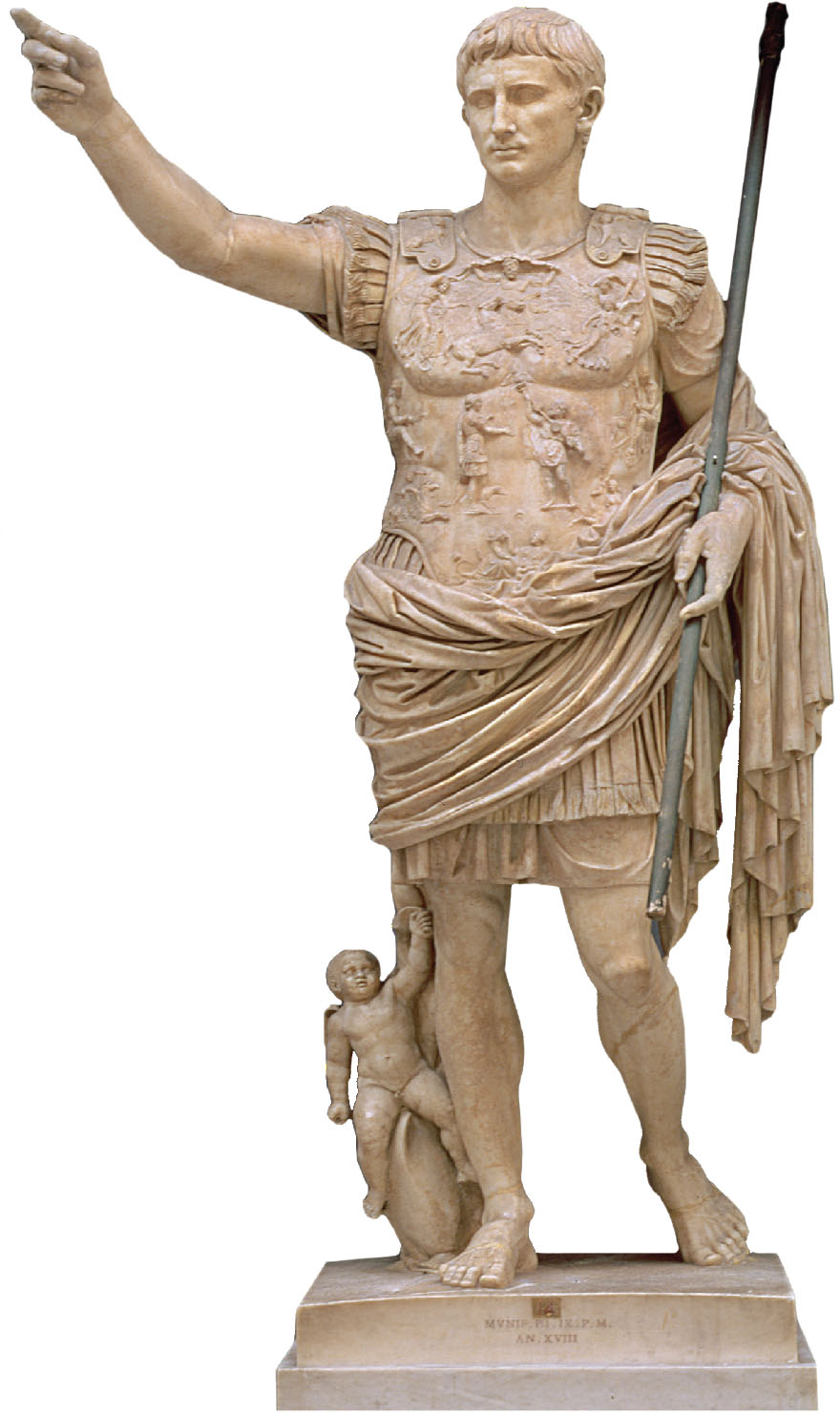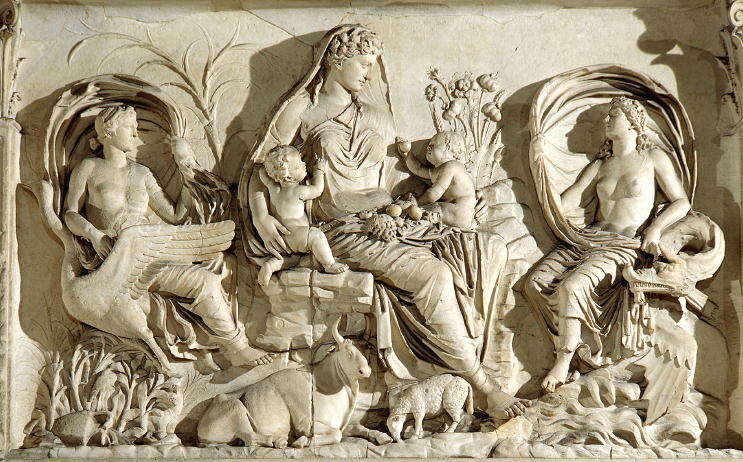Understanding World Societies:
Printed Page 155
The Successes of Augustus
After Augustus ended the civil wars, he faced the monumental problems of reconstruction. He had to rebuild effective government, pay his army for its services, care for the welfare of the provinces, and address the danger of various groups on Rome’s frontiers. Augustus was highly successful in meeting these challenges.
Augustus claimed that he was restoring the republic, but he was actually transforming the government into one in which all power was held by a single ruler. Augustus fit his own position into the republican constitution not by creating a new office for himself but by gradually taking over many of the offices that traditionally had been held by separate people.
The Senate named him often as both consul and tribune. He was also named imperator (ihm-

In this marble statue, found in the villa of Augustus’s widow, Augustus is dressed in a military uniform and in a pose usually used to show leaders addressing their troops. This emphasizes his role as imperator, the head of the army. The figures on his breastplate show various peoples the Romans had defeated or with whom they had made treaties, along with assorted deities. Although Augustus did not declare himself a god — as later Roman emperors would — this statue shows him barefoot, just as gods and heroes were in classical Greek statuary, and accompanied by Cupid riding a dolphin, both symbols of the goddess Venus, whom he claimed as an ancestor. (Scala/Art Resource, NY)
Considering what had happened to Julius Caesar, Augustus wisely wielded all this power in the background, and his period of rule is officially called the “principate.” The Senate continued to exist as a court of law and deliberative body. Without specifically saying so, however, Augustus created the office of emperor. In other reforms, Augustus made provincial administration more orderly and improved its functioning. He further professionalized the army and awarded grants of land in the frontier provinces to veterans. He encouraged local self-
In the social realm, Augustus promoted marriage and childbearing through legal changes that released free women and freedwomen (female slaves who had been freed) from male guardianship if they had given birth to a certain number of children. Men and women who were unmarried or had no children were restricted in the inheritance of property.

In the middle years of Augustus’s reign, the Roman Senate ordered a huge altar, the Ara Pacis, built to honor him and the peace he had brought to the empire. This was decorated with life-
Aside from addressing legal issues and matters of state, Augustus actively encouraged poets and writers. For this reason the period of his rule is known as the “golden age” of Latin literature. Roman poets and prose writers celebrated human accomplishments in works that were highly polished, elegant in style, and intellectual in conception.
Rome’s greatest poet was Virgil (70–
One of the most significant aspects of Augustus’s reign was Roman expansion into northern and western Europe (Map 6.2). Augustus completed the conquest of Spain, founded twelve new towns in Gaul, and saw that the Roman road system linked new settlements with one another and with Italy. After hard fighting, he made the Rhine River the Roman frontier in Germania (Germany). Meanwhile, generals conquered areas as far as the Danube River, and Roman legions penetrated the areas of modern Austria, southern Bavaria, and western Hungary. The regions of modern Serbia, Bulgaria, and Romania also fell. Within this area the legionaries built fortified camps. Roads linked these camps with one another, and settlements grew up around the camps, eventually becoming towns. Traders began to frequent the frontier and to do business with the people who lived there; as a result, for the first time, central and northern Europe came into direct and continuous contact with Mediterranean culture.

ANALYZING THE MAP: How would you summarize the pattern of Roman expansion — that is, which areas were conquered first and which later? How long was Rome able to hold on to territories at the outermost boundaries of its empire?CONNECTIONS: Many of today’s major cities in these areas were founded as Roman colonies. Why do you think so many of these cities were founded along the northern border of Roman territory?
Romans did not force their culture on native people in Roman territories. However, just as earlier ambitious people in the Hellenistic world knew that the surest path to political and social advancement lay in embracing Greek culture and learning to speak Greek (see “Building a Hellenized Society” in Chapter 5), those determined to get ahead now learned Latin and adopted aspects of Roman culture.
>QUICK REVIEW
Why did military commanders grow increasingly powerful in Late Republican Rome?